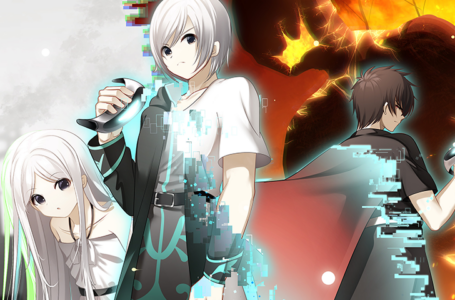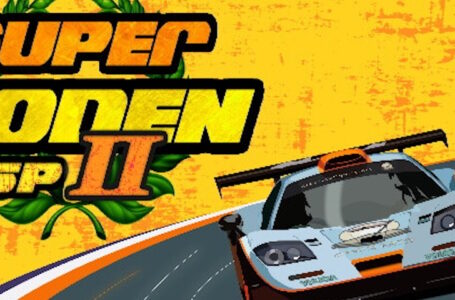Ringlorn Saga shows how you do a great indie retro homage
We’ve had a few indie games pass through recently that were clearly trying to pay homage to classics of years gone by, but which missed the mark in one way or another — sometimes quite spectacularly, sometimes by just not quite nailing the difficulty balance. Ringlorn Saga from Graverobber Foundation is different, though; not only does it absolutely nail the homage aspect, it successfully modernises the concept without, for the most part, feeling anachronistic. It is, in short, a good thing.
In Ringlorn Saga, you take on the role of Prince Gerhard, who is concerned that his father, the King, has been missing for some time after traversing a mysterious magical barrier to investigate what is going on within. Leaving his brother behind to succeed the throne, Gerhard heroically steps through the barrier and immediately gets the shit kicked out of him. After awakening safely in a village thanks to the tender ministrations of a young nurse named Adele, Gerhard swears to track down his father — and perhaps deal with some of the problems in this strange new land in the process.
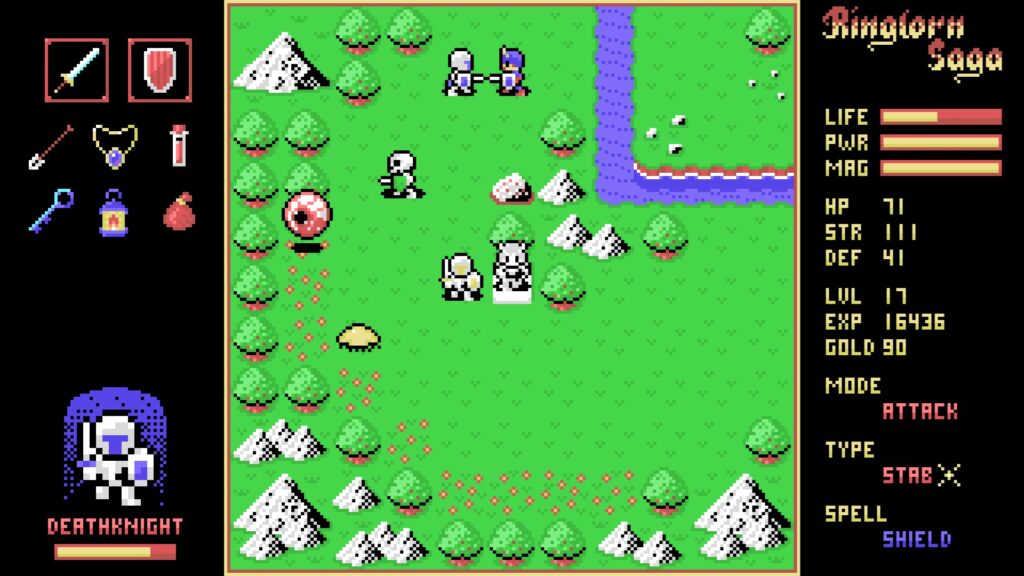
At heart, Ringlorn Saga is an homage to the classic Hydlide series, which first appeared on Japanese home computers in 1984. This was one of the earliest action RPGs following initial tentative steps in that direction by Namco’s The Tower of Druaga and YMCAT’s The Demon Crystal, and one of the first to go all-in on the “RPG” side of that equation.
Hydlide was a pioneer in many respects. It popularised regenerating health mechanics which were subsequently used in later action RPGs such as Falcom’s Ys series; it provided a means of switching between attacking and defensive stances, which is still relatively unusual to see in the genre today; and it was an early open-world game. And yet it’s not all that well-known or liked in the west; this is perhaps down to the fact that it came to English-speaking territories very late, which tended to cause unfavourable comparisons to be made between it and Nintendo’s The Legend of Zelda.
That said, in more recent years, we’ve seen a few distinct homages to Hydlide coming out of the indie space. Several years back, we had Skipmore’s excellent Fairune series, which played up the puzzle solving and exploration aspect considerably more than the combat side of things; Ringlorn Saga, meanwhile, hews a lot closer to the original Hydlide in terms of execution and structure, but adds a few interesting layers atop the original game’s mechanics.
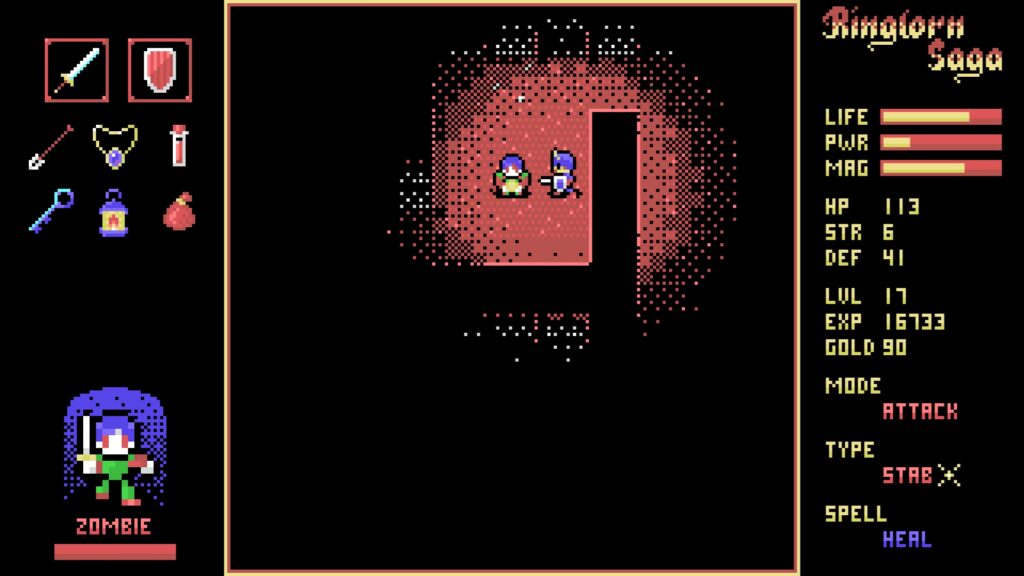
Most notable among these is the way in which combat works. Like the original Hydlide, Ringlorn saga uses “bump” combat, whereby you attack enemies simply by walking into them. There’s a rhythmic aspect to this, however, since although you can move freely in four directions at all times, enemies all move every few “beats”. If you happen to walk into an enemy while they’re walking into you, they can block your attack or even counterattack, dealing damage, so you’re best off trying to time your attacks so they’re between the enemies’ movements.
Facing direction is important, too. Not only does the direction an enemy is facing indicate the direction they’re going to move next, it also affects your attacks. If you attack from the front, enemies are much more likely to block and counter you, even if they’re not moving at the time. Attack from the side or rear, meanwhile, and you’ll be able to deal some safe, unopposed damage.
Finally, the damage type you inflict on an enemy is important. Gerhard’s weapon can be used to slash, stab or bash, and each enemy is weak to a specific attack type. Figuring out who is weak to what is a matter of trial and error initially — though you’ll quickly discover that the answer always makes sense.
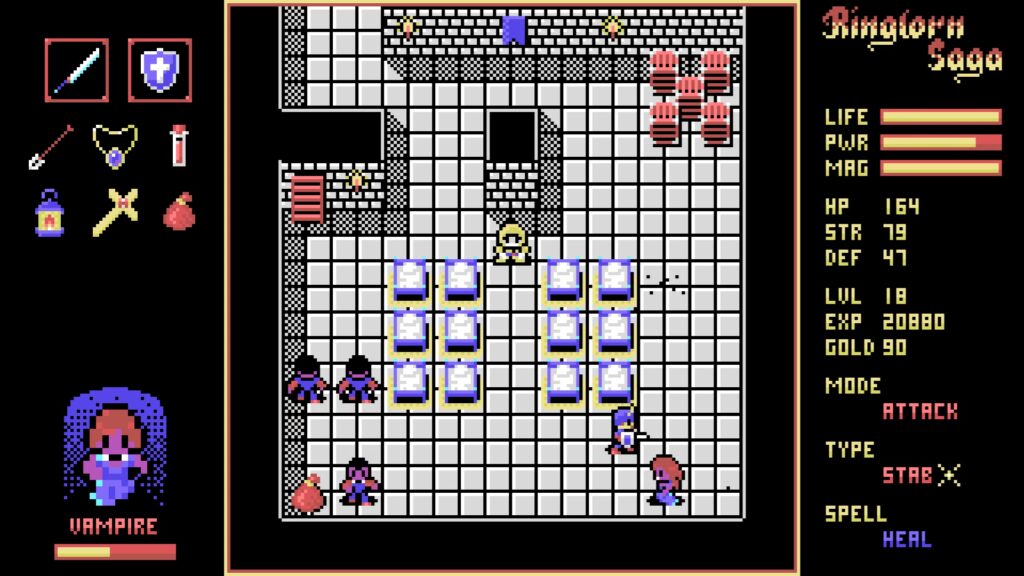
Of course you have to stab vampires, because of the whole “stake through the heart” thing. Of course you have to bash skeletons, because “you can cut the flesh, but you must crush the bone”. And of course you have to slash bats, because that’s the more heroic, dignified alternative to flailing your arms around going “it’s in my hair, it’s in my hair”.
The fact that the enemy weaknesses are always logical means that it’s easy to remember them without having to refer to a bestiary — which is good, because the game doesn’t have one. It doesn’t have a map, either, nor does it have objective markers or a quest log. Much like the original Hydlide, you are mostly on your own in Ringlorn Saga, and it’s up to you to determine exactly what on Earth you’re supposed to be doing, and how to do it.
Rather than feeling aimless and directionless, though, this really helps the open-world aspect of Ringlorn Saga shine. The game world is relatively small, but feels larger because it wraps around in all directions — and you’ll need to take advantage of this to reach certain areas. In stark contrast to today’s three-dimensional open world games, everything in Ringlorn Saga is relevant at some point, even if it isn’t necessarily immediately apparent. By simply investigating the world thoroughly, you will eventually determine that relevance.
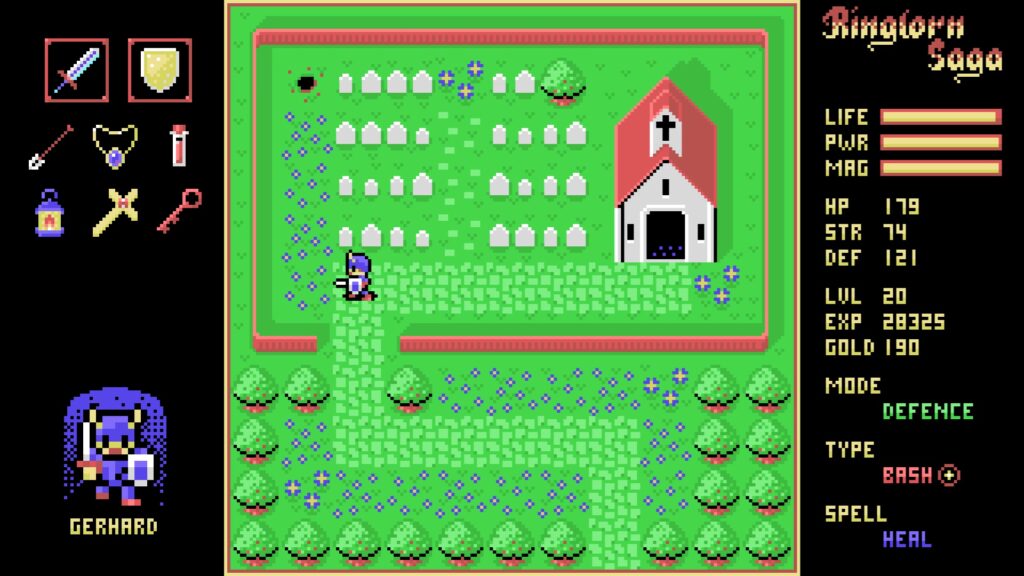
Although there’s a definite “path” through the game that leads you through three dungeons and the bosses therein, a lot of Ringlorn Saga is non-linear, meaning that you can tackle certain things in whatever order you like. Some sidequests are directly relevant to your overall quest, while others simply provide local colour (and perhaps an upgraded item or two), but everything is worth exploring.
There’s no fear of going into areas that are too tough for your character, either, because aside from the dungeons, the game tailors the open-world encounters to always be an appropriate level for your character.
This means that you can always acquire a decent amount of experience from enemies on the way to wherever you’re going, but you can be confident that you won’t get flattened by them unless you’re particularly careless. And even if you do die, you’ll simply respawn back at the starting village minus a bit of experience; a pleasingly modern, player-friendly take on in-game death.
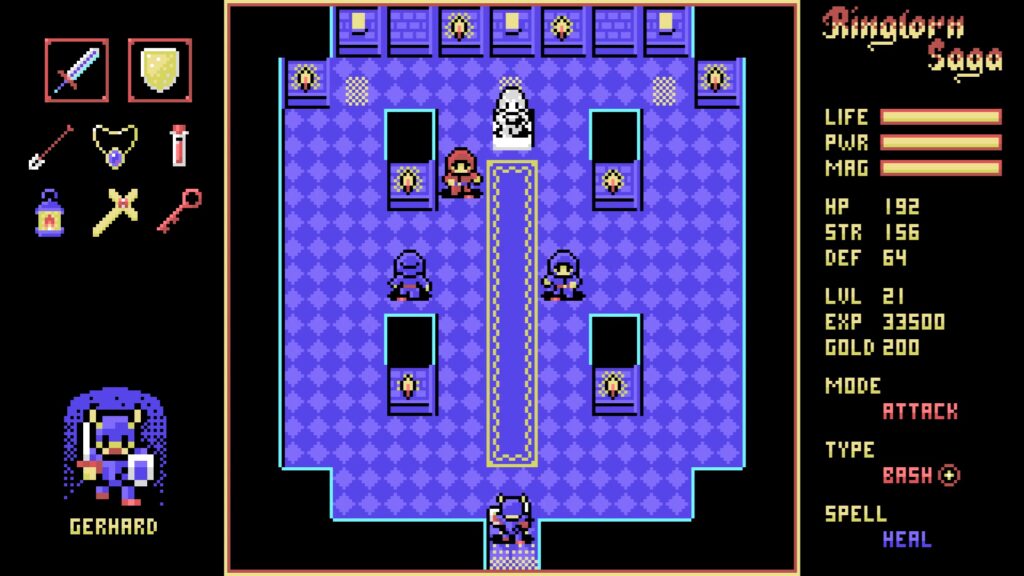
Grinding isn’t really necessary in Ringlorn Saga — unlike Hydlide — because simply exploring and going from place to place will generally net you enough experience and levels to survive the whole game.
You can’t grind for money, either; the only money you acquire in the game comes from very specific places, meaning there’s a finite amount of it available. This is relevant, because without finding all of it, you won’t be able to acquire one of the game’s most powerful items — by no means necessary to beat the game, but a nice “status symbol” if nothing else.
Besides the main game, you can also test your mastery of the combat mechanics with the “Dungeon of Rebirth” bonus challenge. Here, you start as a slime and have to locate coloured keys to escape each floor of the dungeon. Defeat an enemy and you become that enemy as well as acquiring experience points; this is noteworthy, because each enemy has a specific form of attack, so rather than switching between damage types as in the main game, you’ll need to switch between bodies to defeat different foes.
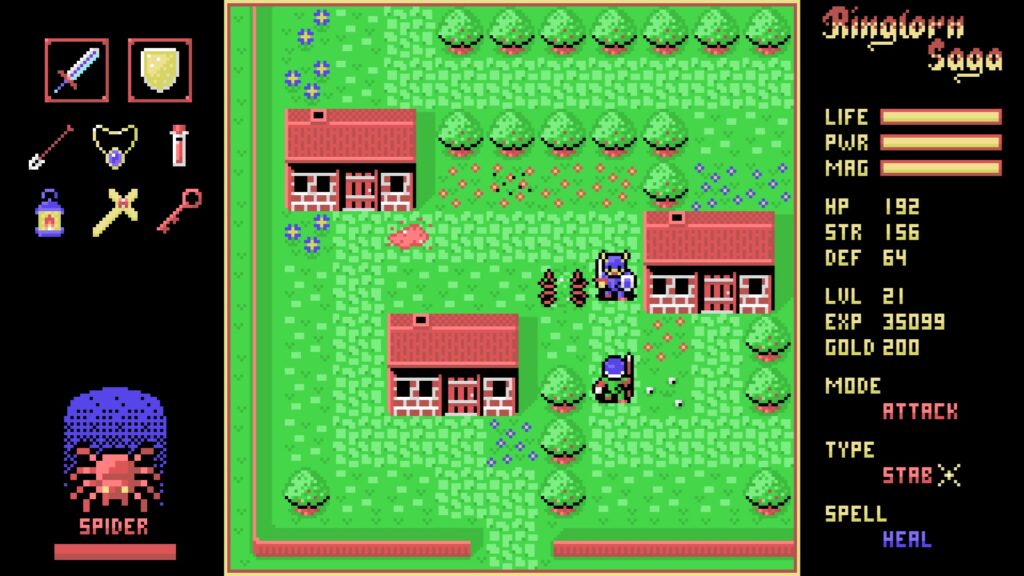
It’s a fun challenge, and really highlights how good the combat in Ringlorn Saga actually is both in the main game and the bonus dungeon. Although simple in execution, the rhythmic nature of it and the emphasis on positioning and facing gives every encounter a distinctly tactical feel. Each room you enter feels like a strategic challenge to overcome, particularly once you start dealing with spellcasters, who can hit or debuff you from range, even without line of sight.
In fact, there aren’t many bad things I can say about Ringlorn Saga. I initially felt like the music was a little anachronistic when placed alongside the graphics, until I imagined the game being released on, say, the PC Engine Super CD system, at which point it made a lot more sense. If you’ve ever played the PC Engine CD version of Ys 1 and 2 you’ll know what I mean.
The one and only area where I might pick fault is more a matter of taste than anything else. For the most part, Ringlorn Saga has this wonderfully melancholic atmosphere to it, created through a combination of the narrative setup, the atmospheric music and the dialogue between characters. It really works well, and left me wondering exactly how things were going to turn out in the story, as minimally told as the tale is for the most part.
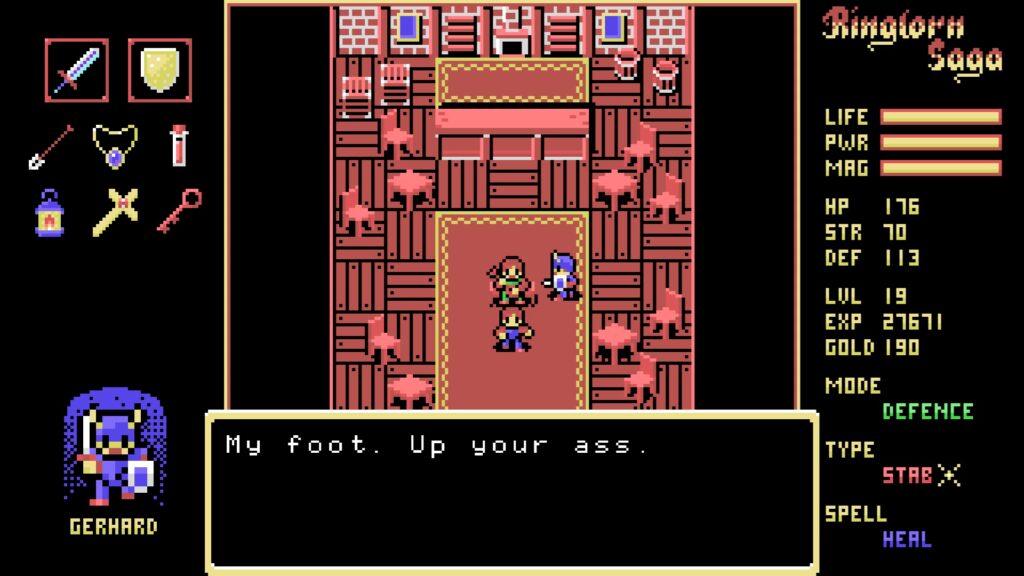
That side of things is good — but it also made the game’s few attempts at humour feel exceedingly out of place. With Gerhard typically talking using fairly flowery language during the main narrative sequences, it’s jarring to see him jokingly talk about putting his foot up someone’s ass or engaging in banter that would feel more at home in a Marvel movie.
These instances are infrequent enough to not spoil the game — in my own playthrough, I only noted two occasions when it happened, but those two instances were both jarring enough to be extremely noticeable. As I say, this is more a matter of taste than anything else; some people might welcome a moment of levity amid all the bleakness elsewhere in the game, but for me these exchanged felt a little out of place.
That little nitpick aside, Ringlorn Saga is an excellent game that I can recommend unreservedly to anyone who enjoys retro-style games. It strikes an excellent balance between paying homage to the classics of yore and bringing things up to date with modern sensibilities and conveniences, and it’s a prime example of why the indie sphere continues to be one of the most exciting sectors in all of gaming.
Ringlorn Saga is available now for PC via Steam. Thanks to Graverobber Foundation for the review code.
Join The Discussion
Rice Digital Discord
Rice Digital Twitter
Rice Digital Facebook
Or write us a letter for the Rice Digital Friday Letters Page by clicking here!
Disclosure: Some links in this article may be affiliate links, which means we may earn a small commission if you make a purchase after clicking on them. This is at no additional cost to you and helps support Rice Digital!
- Letter from the Editor: passing the torch - June 30, 2023
- Super Woden GP 2 is looking promising - June 30, 2023
- Inti Creates is making a 32 bit-style Love Live action platformer - June 26, 2023




